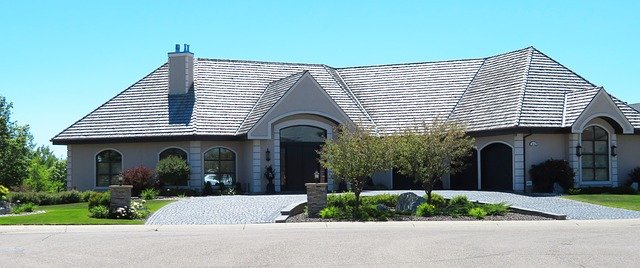
Want to be a Real Estate Photographer? Try this effective guide and become a professional. In this guide, I will explain the exeat step by step process that successful photographers use.
When photography is done for the sole purpose of facilitating a real estate sale, it is called real estate photography. People start spending money on real estate, the agencies managing various sites start looking for an excellent photographer to take beautiful photos of their managed properties.
This is how real estate and photography come together, and a new profession is born – real estate photographer.
It is the first thing you would need to begin as a photographer. Equipment such as costly showy gears will only take as far as your passion goes.
You usually work alone in this field. No one will manage your business for you. It would help if you learned how to shoot, post-produce work, finances, taxes, etc. It is a lonely job.
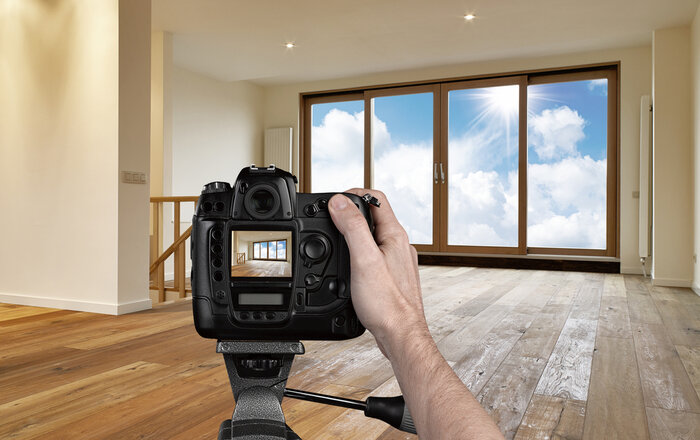
The agents use this image advertise & sell those properties. Real Estate or any other discipline of photography will require you to have a passion for photography.
You should have an eye for detail, understand the play of light and shadow, have innovative creativity, the skill of interacting with society, and know about your limit to achieve great results. You have to have these to e at least considered as a real estate photographer.

Real Estate photography is a branch of photography art. It deals with shooting photos for various real estate agencies.
Besides, a real estate photographer have to deal with -
Commercial photography for another industry has become a huge trend. Photography for real estate has opened a new door to many professional or aspired photographers.
It is a given that you need a few things to get into this business. Let us talk in detail.
The set-off skills you need to improve to become successful.
Real estate or any other discipline of photography will require you to have a passion for photography. Think about a scenario where you are working in a field you do not even love.
Everything will feel meaninglessly boring. But photography has a pre-requisite, and that is the passion for art and beauty. It is not simple at all. It is the first thing you would need to begin as a photographer. You must love the work you do.
This skill can also be called visual skill. Recognize the contrast between shades of light and the stages of darkness in a shadow. Moreover, how to use them in your photo.
You should understand various visual cues that an artist is trained to see. There are rules of photography that you should know and practice.
Not every site of your project will be to your liking every time you visit one. You will face various limitations.
For example, you may not have enough light to work with, or maybe the property itself is in a terrible shape- not very attractive to shoot at. In those cases, you are to improvise and use your intuition to innovate something to creatively take the situation to your advantage. This is where your artistic instinct comes in.
An anti-mentality will not make you an excellent professional photographer. It is an art, and beauty lies in the hearts of people. You have to be good with people if you want to survive.
You alone cannot make a living, and of course, you will not be able to anything if you cannot get your thoughts through to other people.
As a professional, you must accept your limitations and sometimes- defeats for your skills to develop to a newer level.
You stubbornly keep pushing your skills as the best. There will not be any way of improving them. So, you have to know your limits. This is a mandatory skill to survive.
You need gears to shoot photos. The first thing you will need is a DSLR camera that can be released through a cable. Then you may need a flash, several lenses of different capacities and quality, and a trigger that can take photos wirelessly.
You have to use various photography techniques, namely – HRD, blending exposure, multiple exposure light painting, and remote flash. Some apps can connect to the camera remotely and control it and facilitate image preview.
Although the equipment is needed for real estate photography, it is unbelievably inexpensive.
As you will only take photos of stationary objects, you would not need expensive equipment to capture snaps of them.
Let us talk about the equipment in detail. The first thing you will need is a DSLR camera. The camera does not need hi-tech options, for example, auto-focus that requires an action tracking system.
Usually, you will need only a few things- a good DSLR camera, a few right lenses, and a tripod. These are the necessities.
But with the advent of computer technologies, photographers can now do many things, previously not even possible, with Photoshop and Lightroom's help. The software help photographers edit their photos.
Then you may need a flash, several lenses of different capacities and quality, and a trigger that can take photos wirelessly.
Lenses have to be wide-angle. Remember that you are taking photos of real estate. If your camera has a cropped sensor, use a 10 to 22 mm or 12 to 24 mm lens will work. If your camera has a full-frame sensor, then use a lens of 16 to 35 mm.
You will also need tilt-shift camera lenses that will help you keep elements such as edges of the wall, leaning out, and in frames of doors. In the market, you will find various companies selling lenses.
Choose 17 and 24 mm from Canon and 24mm from Nikkon. Other companies also sell lenses of this range, but you should choose from known brands.
These lenses are of fixed focal length, as you can see from the number on the label. You should choose a 16-35 mm lens for varying ranges of perspective that can be zoomed and complements the tilt-shift camera lens.
When you need to shoot images in long exposure, you will call for a tripod.
Therefore, investing some decent money on the tripod.
Tripod brings stability to your images. There will not be any shake from human error.
The most important item after an inexpensive camera will be the tripod. It has to be very sturdy and heavy-duty. Then come to the lenses as explained before.
When you are shooting in low light, you have to use a remote trigger. Because if the camera is in contact during a long exposure photo shoot, the camera will shake, and the photo will be apparent.
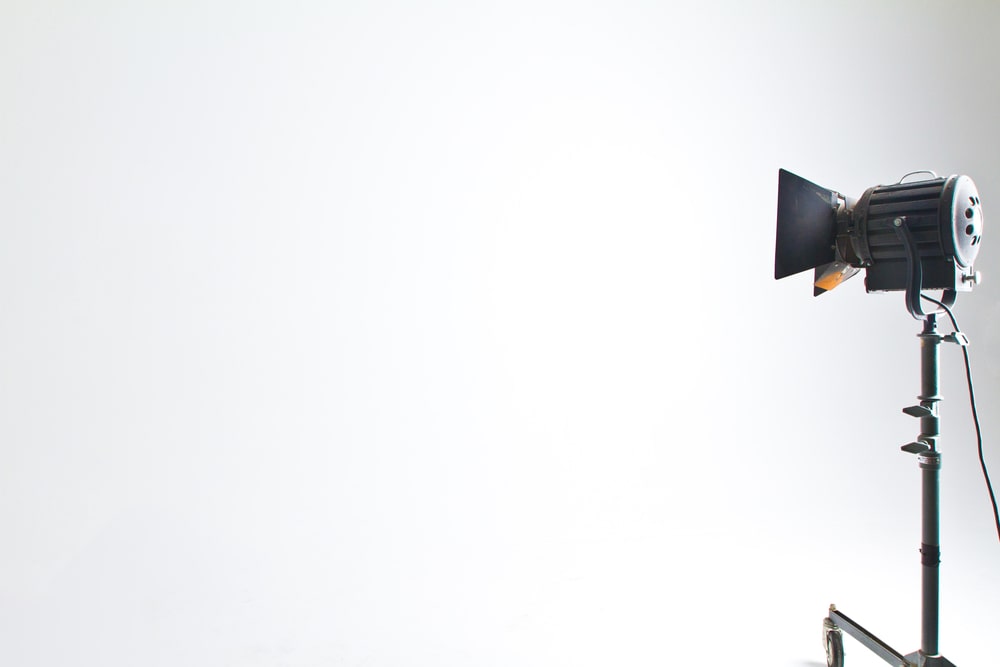
Flash
In real estate photography use of strobes or flashes is not always remembered as one of the most critical pieces of equipment.
But as a real estate photographer, we must remember that not all part of a house gets the same amount light. Therefore, we use flashes to take photos of those parts of your homes.
Flashes are of two types:
Flashguns are cheaper compared to moonlight. Flashgun is not too expensive. But you will need moonlight when you shoot in low light.
Flash Trigger
If you are using external flash equipment, then there can be a need to control the flash outside of the camera.
These are usually connected to the camera's hot shoe and the other side to the flash when you push the buttons with a remote trigger to fire the flash and camera altogether.
Light modifiers
This is also an essential piece of equipment. Flashes are intense, and if we use them directly, they will wash out the image. We will not get excellent output.
Therefore, often we point them toward the roof. At the same time, the light bounces off, and the strength of the light is dampened. But when the ceilings are very high, we will not get the necessary light at all.
That is why it is better to use light modifiers such as shooting umbrellas. They are portable and handy and do not weigh too much. They assist your photoshoot and does not hinder your work.
Light Stands
When we have an external heavy flash unit, we will need light stands. We have only two hands. Moreover, we cannot possibly be carrying the camera itself and also the flash unit.
In that case, light stands will help release your burden, and you will be able to shoot your image without worrying about the light stand.
If you ask this question, you must understand that you have to look into this matter from an employer's point of view.
For example, if you hire a professional photographer and have two choices, both have some photography skills.
But one has a training certificate given by a recognized professional photographer, and the other one does not have any formal training. Who would you hire? There is your answer.
If you think just the skill alone will land you a gig, then you are grossly mistaken. When you are on the same stage with other photographers who have photos of the same qualities as yours, certification will be an added advantage and a deciding factor.
Therefore, you should get some kind of formal training and a certificate to underpin your portfolio.
There are numerous on-campus and online photography courses. You can read online reviews and then decide to enter one.
But the timing is essential. It has to be when you have a firm determination that you will pursue a career in photography no matter what the situation is. Then you have to browse through courses to match your financial capacity.
This is because you need to buy your gear while you enter a professional course in photography. So, you have to save up to a couple of thousand dollars for this course and gears.
Just having a good camera and supporting equipment will not always give the best result.
You will need to learn how to work with your photo or post-processing. It is an essential skill to have.
Otherwise, you will not be able to get the result you have in your mind. Doing everything with your hand will also cut the cost of getting the post-processing job done by someone else.
You will need to learn about Adobe Photoshop and Lightroom and learn how to work with them. Now let us have a look at the essential post-processing skills you will need.
You can correct the color of your image by putting it through Photoshop. The light inside the house, or the weather outside, etc., may affect the quality of color of your image.
You can change these in Photoshop during the post-processing period for a better result. Keep changing various settings until you get your desired results.
You will often find your image a bit washed out or brighter than you have expected.
You can reduce or increase the color's temperature or dim the brightness to a certain permitted degree. Your editing should not make your image unrecognizable from the original copy of the picture.
High Dynamic Range photography is a method where few photos will be taken in different exposures. Then they will be stitched together to give an image of acceptably correct exposure. We need to take multiple shots of the same object at various exposures and then work on them with Photoshop or Lightroom.
Although there is not much to do, you can have the auto-align feature of these pieces of software. There is another solution from Photomatix. This software gives a lot of options to play around with your images.
You can have your pictures directly imported to Photomatix. Among many possibilities to make HDR photos, you can work with the tone, tone mapping, details enhancer, and many more presets.
When we take photos, often our cameras capture more than we want. Cropping is a method to cut out the unimportant objects from our images and only focus on the center object.
We can shift the focus of our appearance to any other item inside the image by cropping. This method gives us freedom of better framing.
It is essential to make sure that your photos are vertically aligned. This will have a good impact on your image.
If the sky in your image lacks charm and seems bland, it can be replaced with a better-looking one with software. This also gives you a better image quality, and buyers will love it.
A skill you must learn. There will be many occasions when you have a perfect photo, but unwanted objects will come with it. This technique will save your day.
Some clients of yours will ask you to put extra little bits and pieces inside your image.
For example, if there is an empty flower vase, you can put some flowers in it. You can also add a screenshot from a movie to the black screen of a turned TV monitor, or you can add fire to a fireplace.
Like every profession, there will be challenges. It cannot be delightful if you don't prepare yourself ahead of time.
When you are working in the commercial field, the thing can get messy. Here is some common problem you will face during a photo shooting project.
This is a tough challenge for real estate photographers. Various light levels are entering a room during day time, and it is challenging to keep up with them and still take a gorgeous photo.
For example, the windows of a sunny room are very bright. Our eyes manage to see through to the other side of the window after changing our physical position.
But the camera needs a lot of work to cancel out the extra brightness from the windows and make them see-through so that we can see what lies on the other side of the glasses.
In this case, you should take 2-5 snaps or use High Dynamic Range (HDR).
Another big challenge to real estate photography is that homeowners often do not remove cluttered objects lying around in the house.
The photographer should talk to the realtor before, so there are no hindrances in front of taking a clear and neat photo. This is the last thing you would want to see in the house during a photoshoot.
Not real estate properties have a lot of space to work with. Some properties have narrower spaces. It is a real challenge to find the right angle and distance to capture most of the room's area.
Usually, positioning the camera right outside the doorway and using a wide-angle lens will solve the problem.
It is not at all acceptable. You want to shoot a property, and you do not have the proper gears with you – this situation is not going to work. You have to go on scouting before you start shooting. Study all the rooms and spaces interior and exterior of the house.
A day-long study will tell you exactly when you will get good light for shooting the interior and the exterior. Always take the house owner or realtor with you to clearly describe actually which features of the house they wish to advertise.
Window light can be a considerable pain to handle if the room during the photoshoot seems darker than the windows.
To solve this, we can take multiple shots of the same object at different exposures and then stitch them together to get a more accurate image of the property.
If you are in photography, then you cannot have yourself without a portfolio up on the Internet. The portfolio is mainly a show-off of your skills in real estate photography.
You gather all the photos you have taken so far and categorize them based on a specific property and interior and exterior shots of that particular property.
These photos will be the face of your business and your skills. Always have your online and printed portfolio at the ready to show them to interested clients. If your clients like them, they will ask for your service, and then you are all set for a job.
As you will be working in real estate, your target customers or clients will build houses and the people who manage them. Thus, you can keep an eye out for new development sites.
Besides, you will have to talk to the developers who are building new buildings in the city and then offer your service to them. You can also visit the real estate agencies that manage various properties in your vicinity and show them your work.
If they are interested after seeing your portfolio, you may have a job waiting for you.
One has to set a very competitive price on his photos to survive in the market flooding with professional photographers. Strategic planning for the price is critical during market research.
A photographer should always look into the bigger picture. Find out how big the city and the population are in the city you are in. If it has a massive population, the chances of volume sales are good.
Therefore, instead of charging US$200+, you can reduce your price depending on the competition down to $150 or less. It would help if you increased the chance for a sale. This is not the time for stubbornness, as many pro photographers tend to charge a lot higher than this.
But the best strategy is to make your name know in the industry so that people start looking for you. When they start coming to you, that is the time you can decide to get a reasonable price on your photo, because now the clients are competing for your service.
The highest bidder will get your service. But you will have to take the driving distance, price of necessary equipment, and workload during post-processing into account if you decide the pricing.
People have been searching for information on becoming a real estate photographer that the search has trending as one of the top searches on the internet.

Have you ever visited real estate agency websites? If you get to visit one, you will see stunning photos of all kinds of properties- houses, condos, penthouses, apartments, buildings- all sorts of architectural establishments for sale or rent.
The photos you see there are taken by real estate photographer. When photographers choose to shoot pictures of real estate establishment for money, this photography is called real estate photography.
Now, this profession has a year-round demand. You may able to keep yourself busy handling clients throughout the year. However, some month is better than others. Let's see the online trends.
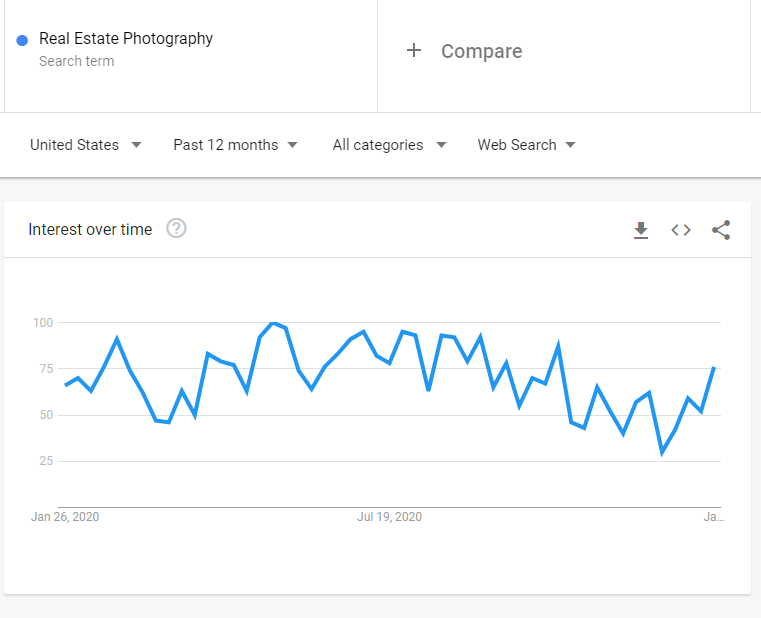
It shows it has a study demand while December and march have below-average search.
If we see the trends of the term "Real Estate Photographers" in Google Trends, we can find spicks in the graph - April to June and January to February. That means this month has the best potential for producing more jobs.
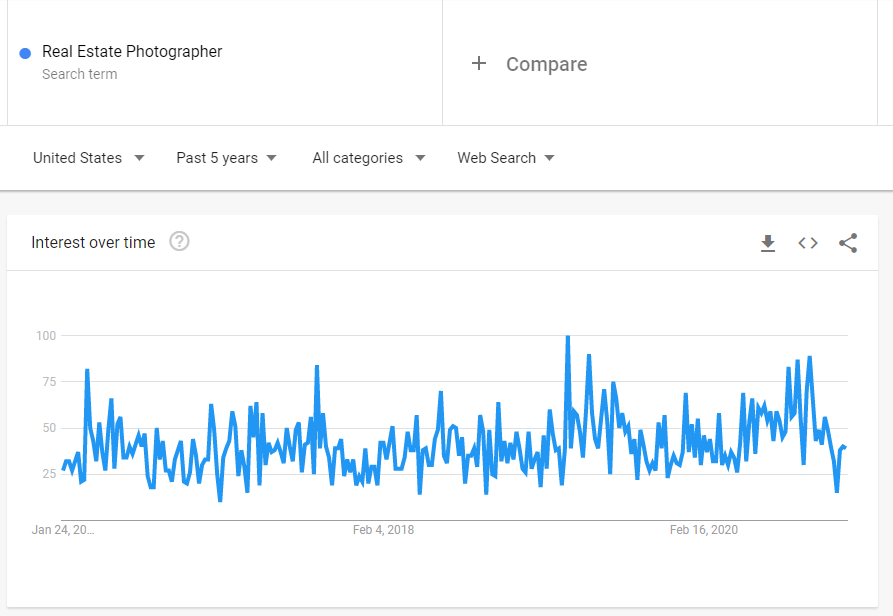
It is a very competitive market because there are more photographers than empty properties to take photos of.
Luckily properties become vacant for rent and sell all the time, and only one photographer is not kept in service of a realtor just because s/he took photos of a house before. It is a year-round job. It is and of freelance work.
Although some realtors employ photographers as permanent in their services, most are freelancers. Creativity and tenacity are needed to survive in this market.
Therefore, you must understand the risks involved in becoming one yourself.
When you shoot for a side income or hobby and gain experience and skills that can be sold, you do not worry about finding a job because it is your extra cash.
But the moment you jump in as a full-time professional photographer, your struggle will begin. So, look before you leap.
The realtors look for a photographer who can give some fresh perspective in their photographs, which will excite the buyers, and realtors can land a sale.
The competition for acceptance by a realtor is fierce. A photographer must fight to the teeth and bite hard with their skills and creativity to survive among the other competent photographers.
Every field of work has its ups and downs. You cannot just say that it is a promising field. It is promising as long as it is working out great for you.
You have to look around and talk to people in the industry to find honest answers about this work line. But it pays if you know how to market yourself.
You have to look around and talk to people in the industry to find out honest answers about this line of work. But it definitely pays if you know how to market yourself.
Photography technology is advancing faster. New types of opportunities are expanding, like 3D real estate photography is becoming popular these days.
Photographers can either work as freelancers or in-house. The ones who work as in-house photographers get paid just like a regular employee.
Therefore, just like any other employee, they may get tax deductions on their salary, health, and other benefits. They work at a company for a very long time just like employees of any other company.
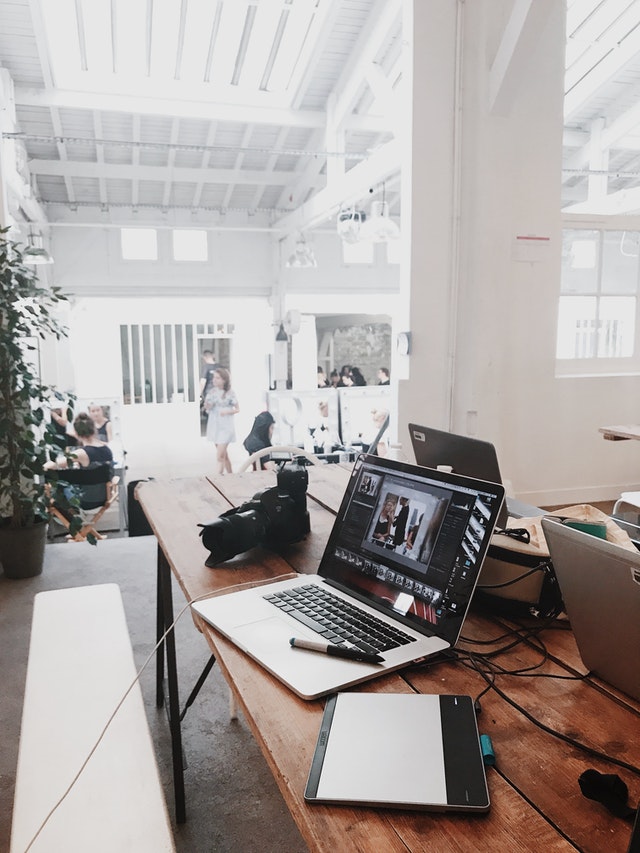
Real estate photographers can work as a freelancer, or they can get hired in a project. Aspiring photographers must understand that the competition is very tough, and they have to look for jobs continually.
On the other hand, let us take the example of a freelance photographer. This job type will hire a photographer for a certain period or a specific project.
They will be signing contracts, and there will not be any employee benefits or anything like that. They will have to pay taxes, though.
Here are few marketplaces you may want to check. Visiting a freelance job site, in general, may not be suitable for serious photographers.
If you are one, you will want to visit the same pond where other fishes like you see for the job. These are the job boards that are created specifically for photographers. The benefit of looking into sites that are dedicated to the photography industry will find you a suitable job faster.
Otherwise, you will have to comb through a lot of garbage that does not fit you at all.
Here are a few places you may want to look into if you are seriously into this industry:
When you are a freelancer, you can decide how much you should be paid for your service, but your employer will determine the salary for your favor when it is about a salaried income.
The standard salary of a real estate photographer stands somewhere around US$50k. With as high as US$62k and as low as US$42k.
As usual, your salary will be decided by the education, certification, achievement, experiences you have, and your portfolio's quality.
Now, let's dig into how you can start your photography career in real estate.
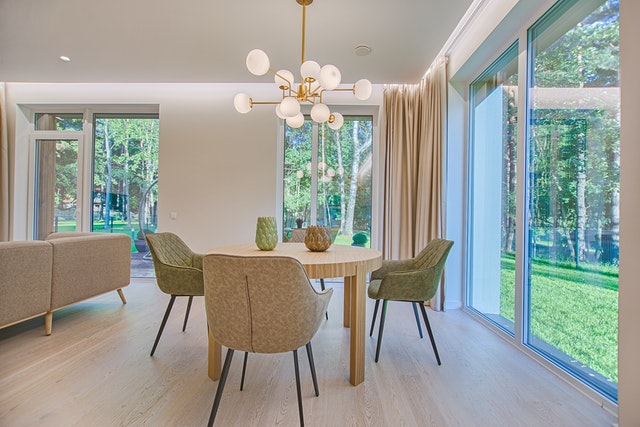
If you are interested in real estate photography, then you should learn a few things. First of all, you need a passion for this rather difficult job. Then you need to know about the gears you need.
You will need to have some education and practical experience in photography, so you should consider taking a course, learn some post-processing skills, and build a portfolio. These will give you the push you need to start this as a career.
As a photographer of real estate, you need to know which image you have to take. The proverb goes, 'Practice makes a man perfect.' You need to practice as much as you can.
You should also study the realtor agency websites. There, you will get to see the pictures of properties that are already on the list. And, you will be able to see how other photographers took their images.
You will take note and then try to mimic the shots by matching the light, angles, and everything. Shoot the exterior and the interior. Do not forget the backyard and the front yard.
Try your best to place your camera parallel to the ground below. Using a tripod will give you a better handle on the shots you take.
Do not tilt your camera too much; otherwise, it will take bad photos. Remember that. Although this can be corrected during the post production, you should stop depending solely on photo edits and try to do your best to take the best photo with just your camera.
Camera technology has come so far. Now cameras have so many functions that a user cannot discover every trick a camera can pull just from its usage. You have to study your camera in and out.
Learn every setting and option and how they affect your image. Always try out the overly advertised functionalities. See the work as announced before you put your money on the line.
If your camera has one, then try it out immediately. See how much you have to expose manually before seeing what a particular shadow has inside it.
Usually, exterior photos are best during the twilight or sunset, so take some during these hours—fiddle with the camera properties to learn how they work.
Despite all the difficulties and competition in the market, people are still finding their new career in real estate photography.
They enter this industry not just for the money because money is hard to come by.
This passion and love for their work are two things that pull them into this industry.
It is essential to find happiness in the work you do. There can be no better way to lead a satisfying life by doing work knowing that you love doing it.